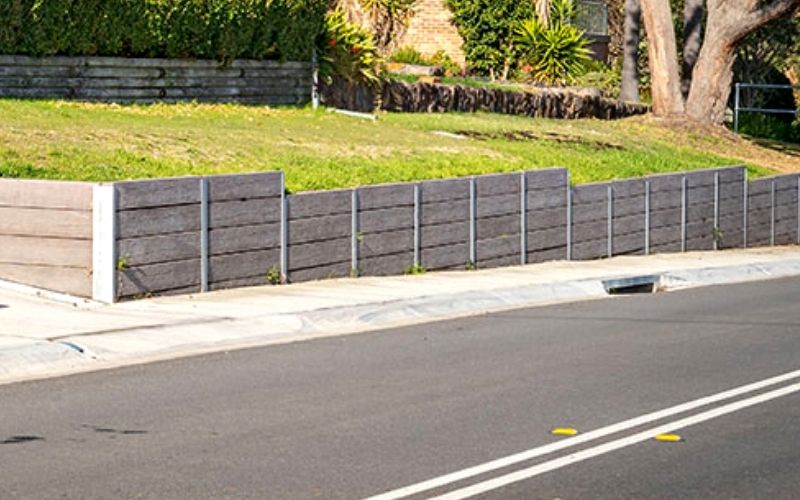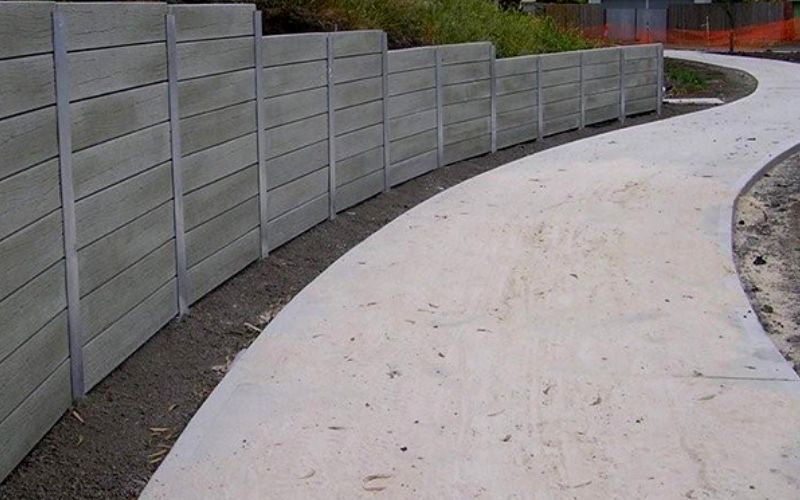How to Build a Concrete Sleeper Retaining Wall
Do you want to construct a retaining wall using concrete sleepers to reduce the cost of doing so?
What is a Concrete Sleeper Retaining Wall?
Concrete sleepers are one of the most significant materials for retaining walls since nearly any design may be used without compromising the material’s structural soundness and use. Concrete can be painted, coloured, and sculpted in various ways, even taking on the appearance of natural stone or being moulded into clean, contemporary shapes. Additionally, concrete can be coloured while prepared, preventing the colours from fading or chipping.
How High Can You Build a Concrete Sleeper Wall?
The sleepers of these retaining walls are strong enough to support soil wedges up to 4 metres since they are made of highly durable concrete, which can be poured into any shape. They can be designed to fulfil any purpose, from creating driveways to landscaping gardens or enclosing roadways and basements, and they are simple to instal.
Depending on the job you want to use sleepers for, such as raising the level of your home’s basement or laying the groundwork for a new garage, they come in various diameters and widths. Professionals should evaluate and install retaining walls when carrying out more substantial construction, such as foundation work, to ensure that all safety regulations are met, the environmental and soil conditions are assessed, and the retaining wall material chosen is suitable for the job.
Table of Contents

How To Make a Concrete Sleeper Retaining Wall Installation in Australia?
Depending on the job you want to use a DIY concrete retaining wall for, such as raising the level of your home’s basement or laying the groundwork for a new garage, they come in various diameters and widths. Professionals should evaluate and install retaining walls when carrying out more substantial construction, such as foundation work, to ensure that all safety regulations are met, the environmental and soil conditions are assessed, and the retaining wall material chosen is suitable for the job.
All of these four steps will help the professional create or how to build a concrete sleeper retaining wall that is flawless and of the highest calibre. It offers a practical construction with the ideal pathway.
Establish the Wall Requirements
Retaining walls typically under 1m in height do not require approval or an engineering certificate before beginning. However, you should check with your local council before starting your sleeper retaining wall project. However, neighbours would typically split the cost of the retaining wall that was to be constructed along property lines. For more unusual circumstances, check with your local government to find out which neighbour is responsible for a retaining wall.
Measure Twice, Cut Once
Depending on the length of the sleeper you purchased—2m or 2.4m—run a string line and then mark out your spaces. For ease of installation, provide a 10mm gap. They will struggle to settle into a position if you don’t give them enough room.
Start Digging
To roughly match the height of the retaining wall, dig a footing at that depth. Dig holes for posts 450mm in diameter and the same depth, with a minimum 100mm concrete cover.
Secure and Build
Once the holes are prepared, install the posts and level them throughout the retaining wall’s length before bracing them up to hold the mould in place while the concrete cures; pour concrete into the holes and level it. The first sleeper should be installed and aligned to a maximum of 83mm. The remaining sleepers can then be added after that. Add the drainage and plastic membrane as necessary, then backfill to complete the project.
What Are The Types of Concrete Sleeper Retaining Walls?
Concrete retaining walls can be divided into three categories based on their construction style and working procedures. Block retaining walls and sleeper retaining walls, composed of concrete having wall blocks and concrete retaining wall sleepers, respectively, are also famous on smaller retaining walls, where lesser lateral loads are imposed.
Anchored Concrete Sleeper Retaining Wall
When a tall retaining wall wedge with a narrow cross-section is needed, anchored retaining walls are typically provided. Driven sideways and deep, wires or deep cable rods are then fixed by having concrete poured on top of them. These tiebacks or anchors prevent the retaining wall from slipping or toppling over.
A drainage system is offered, much like other techniques, to prevent excessive lateral pressure brought on by the water.
Cantilever Concrete Sleeper Retaining Wall
Reinforced concrete is used to construct cantilever walls, and an L-shaped (or inverted T-shaped) foundation is used. The vertical tension behind the wall is transferred onto the foundation to minimise toppling caused by lateral earth pressure from the same soil mass.
Gravity Concrete Sleeper Retaining Wall
A gravity retaining wall employs its weight to balance off lateral soil loads. Because of this, gravity walls are often larger and heavier than other retaining walls. Up to three metres of high retaining walls can be constructed with it.
What Are The Benefits of Building a Concrete Sleeper Retaining Wall?
A concrete sleeper wall is adaptable since it may be poured into many designs, in addition to its general toughness and endurance. Because of this, they are a perfect fit for tasks like landscaping and landscape design. Additionally, adding artistic components and colours to the sleepers is simple to give them a more appealing appearance.
So, for just about any project you have in mind, concrete sleeper retaining walls are a terrific option. Concrete can conform to your design vision because it is sturdy and adaptable. Additionally, installation is also relatively simple.
An excellent solution to a steep slope is a concrete sleeper retaining wall. It is less expensive and more accessible for homeowners to construct than a typical retaining wall. Concrete sleeper retaining walls are less expensive, energy-efficient, and require less upkeep. Additionally, the identical builder instals a concrete sleeper retrained garden.
How Long Will A Concrete Sleeper Retaining Wall Last?
A concrete sleeper retaining wall should endure 50 to 100 years or longer, depending on how well it is maintained. In contrast, stone retaining walls can survive up to 100 years, whereas cantilever sleepers typically last 15 to 20 years.

How Much Does A Concrete Sleeper Retaining Wall Project Cost?
The cost of of your concrete sleeper retaining wall will depend on various elements, including the size of the project, the number of concrete sleepers needed, fees for design and consulting, and the services of a structural engineer or other experts. Depending on other elements, such as reinforcement, the cost of concrete sleepers in Australia ranges from $450 to $700 per square metre. You can get a quote and a breakdown of the expenses from a retaining wall builder.
Are Concrete Sleeper Retaining Walls Cost-Efficient More Than Sandstone and Timber?
A quick and inexpensive technique to build a retaining wall is with concrete sleepers. It’s a substantial pick for numerous occasions. When there isn’t much area available, it’s an attractive choice for retaining wall construction. Since they can last for many years, they must be built appropriately. Concrete sleeper walls are easy and inexpensive retaining walls.
Final Thoughts
Hopefully, this article has given you the instructions to construct the stepped concrete sleeper retaining wall yourself. Without a doubt, you can work with a qualified contractor for your construction project.
